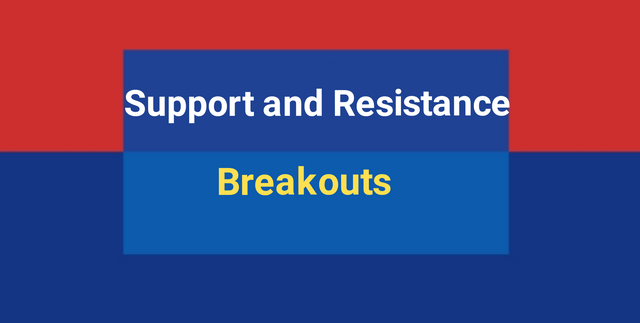
Source

1.- Explain in detail the advantages of locating support and resistance on a chart before trading.

Support and resistance levels or areas when it comes to trading are two highly talked-about attributes of the process of technical analysis. In the process of technical analysis whereby chart patterns are examined traders employ the terms resistance and support in their description of price levels or areas that act as barriers that either prevent the price from pushing further downwards or upwards.
At the onset, explaining the idea behind the formation or creation of these levels may appear to be simple. However, you may eventually discover that the concept of resistance and support could appear in different forms thereby making it a little bit not too easy to take mastery of.
In technical analysis, support and resistance can be used as important levels to determine high probability pause in trend or even reversal of an ongoing trend. Support is usually reached when this sort of pause is created in a downtrending market as a result of concentrated demand for the asset at that level.
A level of resistance is conversely created in a market that is in an uptrend but suddenly experiences a sort of pause which is often temporary as a result of concentrated supply of the asset at such a level. In the creation of these levels it should be remembered that market psychology normally plays an important part due to the fact that investors would usually remember how the price had reacted in the past to the different changes being made by the asset and would therefore wish to participate at such important levels.
Importance Or Advantages Of Support And Resistance
Support and resistance are very important areas in the market because they act as a guide to traders when entering or exiting the market. The ability of a trader to mark out these levels would give him a clear view of the structure of the market. Identifying the market structure would be instrumental in helping the trader to predict the likely direction the price is probably going to take from there. Equally, it could help them determine the size or length of the imminent market move.
The idea behind the entire phenomenon is that these levels have the ability of stopping the price action from continuing in its prior direction and even making it reverse from there. Consequently, it is a common practice that traders would often open buy trades when the price is trading around the support region. On the other hand, the traders would usually enter sell trades when the price is trading around the resistance region.
Furthermore, resistance and support levels could be of advantage to traders in helping them determine where to exit or close their open positions. In this regard, a trader who has a running long position would consider the upcoming levels that had previously acted as resistance as areas where he should be taking profit.
In the same vein, a trader who has a running short position would be at advantage with his good knowledge of support and resistance as he would be anticipating the upcoming areas where the market had previously refused to continue downwards as the support regions where he should be exiting this position.

2.- Explain in your own words the breakout of support and resistance, show screenshots for the breakout of a resistance, use another indicator as a filter.

Breakout of support and resistance are important areas because it could be of essence in helping traders to identify the early stages of a new trend. This would hence make it possible for them to open positions and benefit maximally from the ensuing trend. Price breakout points could signal the beginning of major moves as there is usually an expansion or increase in the market volatility.
Price breakout usually occurs whenever the price which had been moving within a predetermined level or range of price action suddenly moves either above the resistance level or shoots down below the support level.
A breakout of a support region or level refers to a situation whereby the price action which had been trading in between an upper price ceiling and a lower price floor suddenly breaks below the lower floor or support region. Normally, this would be followed by an increase in the volume. Ordinarily, it is expected that once the price breaks below the support region it should continue in that direction in which it has broken out. However, this is not always the case and we will examine the reason for this exceptions subsequently.
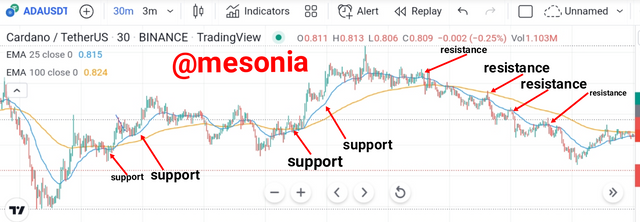
Source
One of the indicators that can be used to identify support and resistance levels are moving averages. In the image above it can be easily seen that in an uptrend the price action usually returns to some point where it touches the moving average and simply bounces off backwards and continues upwards. It does this severally and these points of reaction can be identified as the levels where the market finds support.
Resistance Breakout
A breakout of a resistance region or level refers to a situation whereby the price action which had been trading in between a lower price floor and an upper price ceiling suddenly breaks above the upper ceiling or resistance region. Normally, this will be followed by an increase in the volume of the market. It is expected that once the price breaks above the support region it should continue in that direction in which it has broken out. Nevertheless, this may not always be the case.
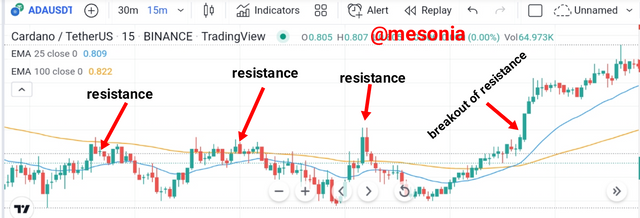
Source
The moving average can also be used to identify resistance. Whether in a downtrending market or even in a sideways market the price action normally returns to some point where it touches the moving average with its upper part and bounces back downwards in continuation of it downwards movement. It often does this severally. These points of reaction can be identified as important levels where the market meets resistance.
In the image above resistance was broken and the short-term EMA which is a moving average simply moves above the long-term EMA signalling a switch to an uptrend due to the breakout of resistance. In the screenshots the short-term EMA is the blue-coloured 25 periods EMA while the long-term EMA is the 100 periods EMA.

3.- Show and explain support breakout, use additional indicator as filter, show screenshots.

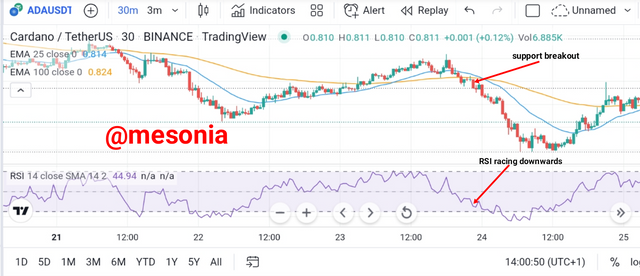
Source
In the case of break out of support as shown in the image above you will discover that the price had been in a short-term uptrend or retracement. Suddenly, a resistance was created and this equally led to a support perculating below. This support was to be retested the second time but was broken. The short-term EMA which is blue in colour (that is, the 25 periods EMA) which had shortly been above the long-term EMA (that is, the 100 periods EMA) immediately moved below the 100 periods EMA signalling a switch to a downtrend as a result of an aggressive break out of the support zone.
To serve as a filter, an additional indicator which is the RSI was used to confirm the breakout of support as shown above. As resist support is broken the RSI indicator begins to move sharply away from the 50 midline and moving downwards towards the 30th mark. This is a sign of increased momentum to the downside and confirms that it is not a false breakout.
Breakouts become more explosive when they occur as a breakout of price action that had been trading within a channel. Such channel breakouts could occur in several ways which can include flags, triangles or even head and shoulders patterns. Breakout from these different market structures are usually because in the formation of these structures there is always a contraction in the volatility of the market. Such contractions are expected to expand once the breakout occurs above or below the identified ranges.

4.- Explain what a false breakout is and how to avoid trading at that time. Show screenshots.

A false breakout is created when the price of an asset moves below or above an important support or resistance level in a temporary way but almost immediately or shortly afterwards retreats to the same side of the market from where it seems to have broken out against.
A trader who may have entered in the direction of the breakout immediately it occurs would have experienced the worst case scenario when he discovers that the price almost immediately bounces back to where it had broken off from and may even actually go in the direction it seemed to have broken out against.
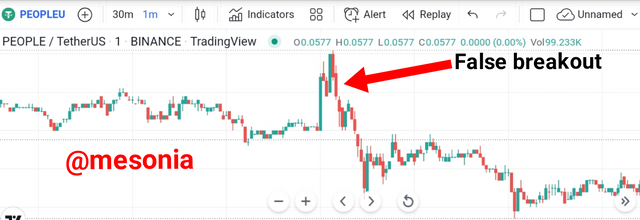
Source
False breakouts usually occur as a result of the games that market makers or institutional traders play in the market in order to fill out their very large orders that may not always have been filled normally.
Take for instance, in the image above you will discover that there had been a false breakout of the resistance zone towards the upside. However looking clearly and discovering that the price eventually moved against this breakout and even went in the downward direction tremendously reveals that the institutional traders who had earlier opened sell trades at the level of the resistance but may have some large chunk of their sell orders unfilled decided to enter buy trades that pushed the market upwards above the resistance where people who had short the market at the resistance zone would have probably set their stop losses which are actually buy orders.
Having pushed the market upwards with their large buy orders they now open sell orders in the opposite direction. With these sell orders the take out the buy stop loss of other retail traders who had actually short the market but who now have their stop loss being hit. Since their sell orders are usually very large the market immediately moves in their anticipated direction which is downwards.
A great way to avoid this trap is to always wait for the break and retest strategy. With this strategy one should observe a break out without entering the market immediately. Then, you should wait for the retest of the level that had been broken out (and this is usually the case in most scenarios).

Source
Once the retest has been completed the price would continue to move in the direction of the breakout. This would be the confirmation that it is a genuine breakout. You can then enter in the direction of the breakout or wait for the price to actually break above the highest point which had been created by the first breakout candle before entering a position.

5.- On a demo account, execute a trade when there is a resistance breakout, do your analysis. Screenshots are required.

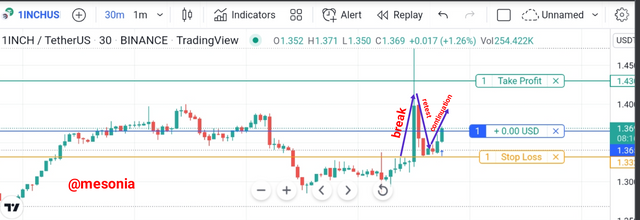
Source
In the image above you will observe that there has been a breakout of the resistance level. The breakout had returned to retest this level to know whether it would hold. The level did hold and the price was now turning bank in the same direction as the original breakout. This confirms the break and retest strategy. In this 30-minute time frame I now took a bite and three as the candle was returning in the original direction of the breakout.

Source
However, even moving up a bit higher on the 4 hour time frame shows that a double bottom was probably forming. Two minima had been created by the price with the first and second bottoms. A local peak which was actually the original breakout of the resistance had found the neckline of the price action. The price was now headed to break above the neckline and this portends a possibly very profitable bullish run.

Source
From the image above you would see details of the demo trade which I took on tradingview.com.

6.- In a demo account, execute a trade when there is a support break, do your analysis. Screenshots are required.


Source
On the chart above you will discover that the price has been trading within a range delineated by the two horizontal lines. Suddenly, this range was broken to the downside. The resistance which had been retested and had held severally was now broken. The price has now gone back to retest the broken support and was already forming a bullish candle.
With the formation of this bullish candle I took an entry based on the break and retest strategy which was being completed. You should note that I equally had the option of waiting for the price to break below the initial swing low of the first breakout before taking an entry.
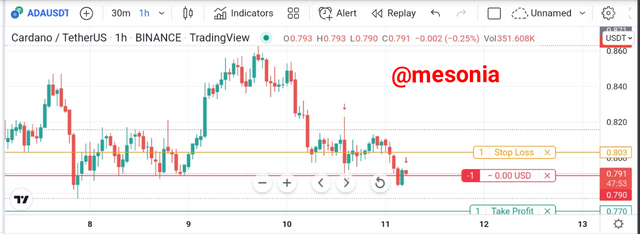
Source
Having taken the entry I set my stop loss behind the initial breakout and set my take profit with a view of an upcoming support level. Currently, we were not yet in gain as is shown by the details below:-

Source

CONCLUSION

The knowledge of support and resistance when trading cryptocurrencies is very important for several reasons. First, support and resistance give us an idea of the regions where the market has met key reactions as a result of supply or demand of the asset in large quantities. This means that a lot of orders are opened at these levels and our markets have the greater chances of being completely filled in such areas.
It is always important to understand how to make entries at these levels or how to close open positions at these levels for maximum gains or to cut down on losses. Equally, it is important to understand how to stay out of the games institutional traders play by looking out for how to properly trade break out in order to avoid paying faked out or stop out of the market unnecessarily at these levels.

Cc:-
@pelon53